Jose Dubeux, D. Abreu, L. Dantas, A. Blount, E. Santos, D. Jaramillo, F. van Cleef, Carlos Garcia, UF/IFAS North Florida Research and Education Center
Introduction
Black oat (Avena strigosa Schreb) is a cool-season annual grass that has a Mediterranean origin and has been used in Europe for centuries. Black oat has been successfully used in the southern portion of South America, in regions with similar latitude to Florida. It is best adapted to sandy or loamy soils, but it also grows in heavy clay, and soils with low fertility. Black oat produces forage similar to other cool-season small grains such as Triticale and Cereal Rye, but usually with better forage quality. Compared to annual ryegrass or other cool-season small grains, black oats are more heat tolerant and disease resistant. Black oats are not cold hardy, but they are recommended for the USDA Plant Hardiness Zones 8b-10a (USDA-ARS-NSDL, 2005). Therefore, black oats are a forage option in most of Florida (Okeechobee North). Black oats are also considered one of the best forages in terms of quality. Crude protein of black oats often ranges from 18 to 25%, and digestibility typically ranges from 70 to 80% (Restelatto et al., 2013). Leaves are usually wider than regular oats. Black oats present similar yields, but better forage quality than cereal rye. In summary, black oats might be a good fit for livestock systems in Florida, considering it is more heat tolerant and disease resistant than other cool-season grasses (Figure 1). New varieties of black oats are being studied to determine basic information, including seeding rate, as compared with traditional oat (Avena sativa). Because black oats have smaller seeds compared to oats, optimum seeding rate might be different.
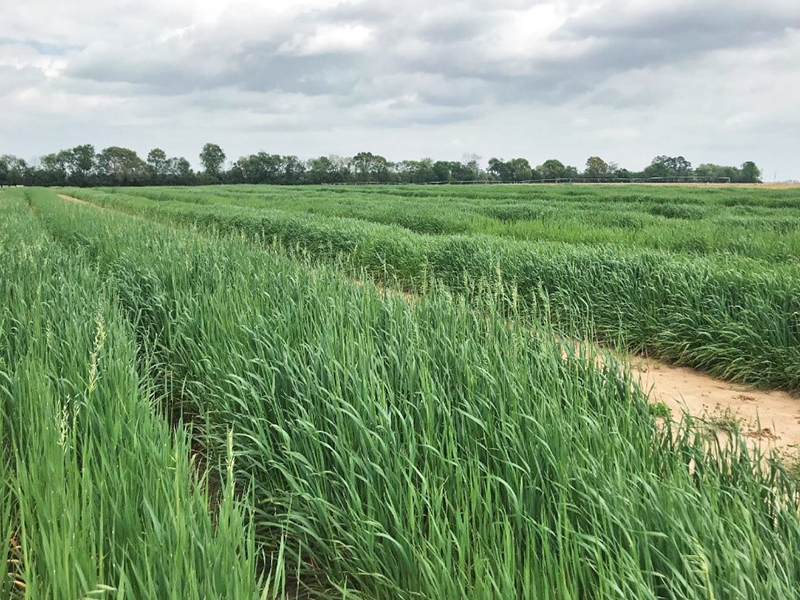
Figure 1. Seed increase of black oat experimental lines in Marianna, FL (04/02/2018). Photo credit: Jose Dubeux, UF/IFAS
–
Research Trial
The objective of the research trial conducted at the North Florida Research and Education Center, Marianna, Florida, was to assess the effect of seeding rates on productive and morphological responses of oats and black oats. University of Florida scientists tested one variety of oat (Legend 567) and one line of black oat (UF-10) planted at five seeding rates (15, 30, 60, 120, 240 lb/acre) with 4 replications, over two years. Plots were seeded in December in 2018 and November in 2019. Fertilization for both years included 250 lb/acre of 20-5-20 (1/8/2019 and 12/23/2019), and a second applicatgion after first harvest . Harvest dates were 3/8, 4/4 and 5/29/2019 and 2/12, 3/11, and 4/13/2020, at 10-cm stubble height. They counted tillers using two 0.25-m2 quadrats per plot. Herbage accumulation was estimated harvesting the central portion of the plot (3 x 11 ft.). Samples were dried at 131 F for 48 h. Results were expressed on a dry-matter (DM131° F) basis.
–
Results
Average seed number per 10 g of seed:
Legend 567 (oat): 311 seeds/10 g
UF-10 (black oat): 484 seeds/10 g (55.6% more seeds per unit of seed weight)
–
Tiller density and mass
UF-10 Black oat had more tillers per unit area compared to Legend 567 oat, at a given seeding rate, and that difference accentuated at greater seeding rates (Figure 2). Black oat has smaller seed size and less seeds per unit of mass, therefore, at the same seeding rate (lb/acre), we are planting more seeds of black oat per unit area compared with Legend 567 oat. This result suggests that a lower seeding rate for black oat will achieve a similar stand, when compared to traditional oat.
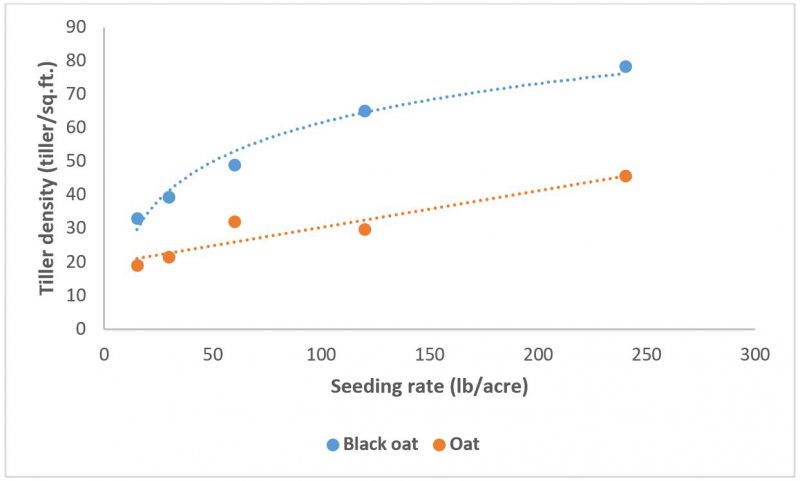
Figure 2. Tiller density of Legend 567 oat and UF-10 black oat at different seeding rates. Average of two years, three harvests, and four replications.
–
As seeding rate increased, both oat and black oat reduced the mass per unit of tiller, which means that each individual tiller was lighter (Figure 3). This is a compensation mechanism, also known as phenotypic plasticity, where plants adapt themselves by reducing their size when competition for resources is greater, as typically happens at greater seeding rates.
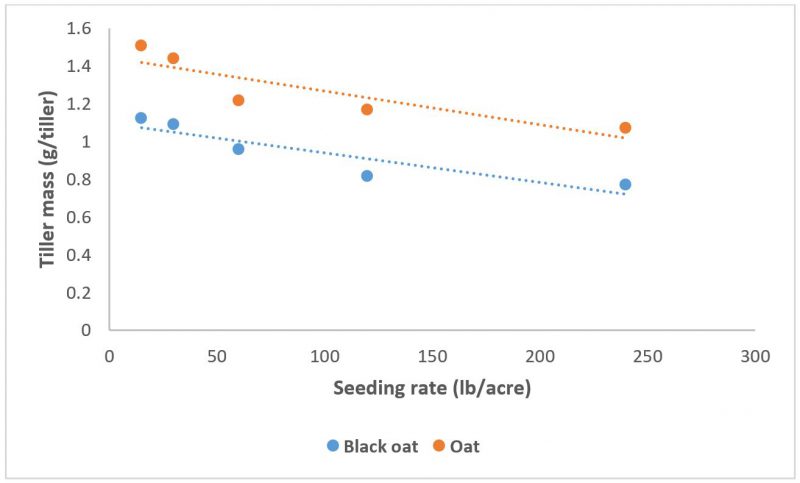
Figure 3. Tiller mass of Legend 567 oat and UF-10 black oat at different seeding rates. Average of two years, three harvests, and four replications.

Figure 4. Contrasting seeding rates of oats and black oats at UF IFAS NFREC Marianna, FL. Photo credit: Jose Dubeux, UF/IFAS
Forage Yield (DM lbs./A)
Herbage accumulation (yield) increased with seeding rate for both black oat and oat to a point and then stabilized thereafter (Figure 5); however, black oat peaked at a lower seeding rate, as compared with traditional oats. At the seeding rate of 30 lb/acre, black oat reached optimal yield, with relative small increase in herbage accumulation when increasing the seeding rate from 30 to 60 lb/acre. Oats, however, peaked at a greater seeding rate (100-120lb/acre). At the lower seeding rate (30 lb/A), black oat presented greater herbage accumulation than oats. At greater seeding rate, there were not many differences between oats and black oats.
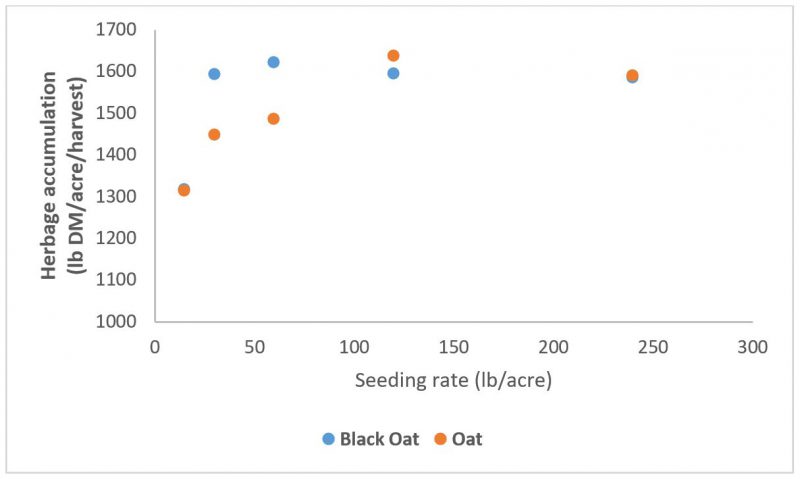
Figure 5. Herbage accumulation of oat (Legend 567) and black oat (UF 10) at different seeding rates; Marianna, FL. Average of two years, three harvests, and four replications. Standard error = 389 lb DM/acre.
–
Black oats and oats had similar yields in the first two harvests, but in the April harvest, black oats had greater herbage accumulation (Figure 6).

Figure 6. Herbage accumulation of oat (Legend 567) and black oat (UF 10) at different harvest dates; Marianna, FL. Average of two years, five seeding rates, and four replications. Standard error = 375 lb DM/acre.
–
Seeding rate played a more important role in herbage accumulation in the first harvest in February (Figure 7); however, the March and April harvests were not as affected by seeding rate. That likely reflects the mechanism of tiller compensation and greater tiller mortality at higher seeding rates (Figure 7).
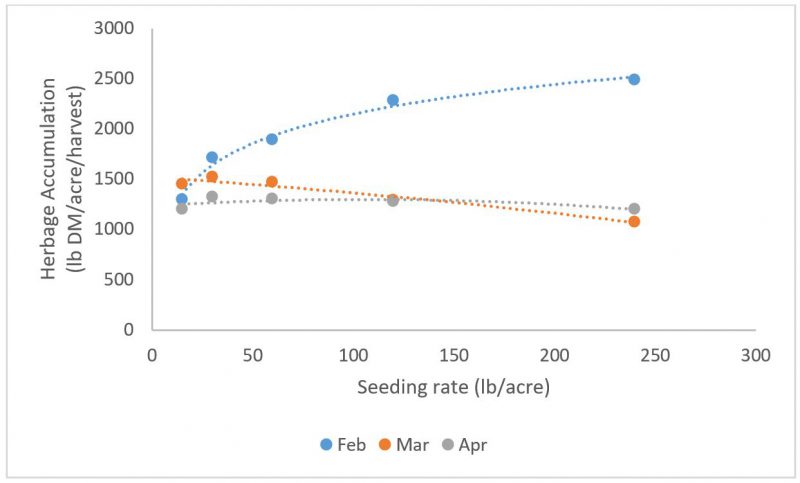
Figure 7. Herbage accumulation of oat (Legend 567) and black oat (UF 10) at different seeding rates and harvest dates; Marianna, FL. Average of two years and four replications. Standard error = 406 lb DM/acre.
–
Take Home Message
Seeding rate affected the performance of oats and black oats, but this effect was more notable at the first harvest. At similar seeding rates, black oats had greater stands than oats. At the lower seeding rate (30 lb/A), black oats produced more than regular oats, reaching its full potential at a lower seeding rate, compared to oats. Increasing seeding rate resulted in greater plant population, but reduced leaf width and tended to reduce tiller weight. For cover cropping use or forages, black oats could be a great option at a seeding rate of only 30 lb/acre.
–
References:
Restelatto, R., P.S. Pavinato, L.R. Sartor, and S.J. Paixão. 2013. Production and nutritional value of sorghum and black oat forages under nitrogen fertilization. Grass and Forage Science, 69:693-704.
USDA-ARS-NSDL. 2005. SoilSaver-A Black Oat Winter Cover Crop for the Lower Southeastern Coastal Plain. Conservation Systems Fact Sheet No. 01. C
- 2025 UF/IFAS Forage Legume Conference – May 1 - March 28, 2025
- How are My Cool-season Forages Recovering from the Snowfall and Low Temperatures? - January 31, 2025
- Integrated Crop-Livestock Systems Improve Soil Health - July 26, 2024
